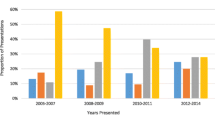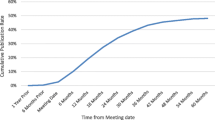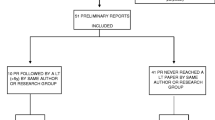Abstract
Purpose
The objective of this study was to determine whether opinion leaders in the medical community attract more attention than randomized controlled trials (RCT) in shoulder surgery.
Methods
A PubMed search to retrieve all therapeutic and diagnosis RCT shoulder studies was carried out. Three opinion leaders were chosen from among the last ten presidents of the European Shoulder and Elbow Society based on the number of publications. Their studies were also retrieved from PubMed. The metrics of the studies were determined through ResearchGate and Web of Science. The year of publication, impact factor of the journal, level of evidence, number of citations, number of reads, research interest, and reported conflicts of interest were recorded for every study.
Results
Two-hundred forty-five shoulder RCTs and 236 opinion leader studies met the inclusion criteria. The opinion leader studies were read significantly more times than the RCTs (p = 0.04). The mean impact factor for RCT studies was 2.84 (SD 3.9) while it was of 1.99 (SD1.14) in the opinion leader group (p < 0.001). Most of the studies of the opinion leaders were level IV (73.3%), while only 6.3% of their papers were categorized as levels I–II. Conflict of interest was present in 19.6% of the RCTs and in 32.2% of the opinion leader studies (p < 0.001).
Conclusion
The medical community pays more attention to opinion leader studies in shoulder surgery than to RCT studies even though RCTs are published in higher impact factor journals and opinion leader studies are mainly level IV evidence studies.
Similar content being viewed by others
References
Lomas J, Enkin M, Anderson GM, Hannah WJ, Vayda E, Singer J (1991) Opinion leaders vs audit and feedback to implement practice guidelines. JAMA. 265:2202–2207
Evidence-Based Medicine Working Group (1992) Evidence-based medicine: a new approach to teaching the practice of medicine. JAMA 268:2420–2425. https://doi.org/10.1001/jama.1992.03490170092032
Cunningham BP, Harmsen S, Kweon C, Patterson J, Waldrop R, McLaren A, McLemore R (2013) Have levels of evidence improved the quality of orthopaedic research? Clin Orthop Relat Rese. 471:3679–3686. https://doi.org/10.1007/s11999-013-3159-4
OCEBM Working Group (2011) The Oxford 2011 Levels of Evidence. Oxford Centre for Evidence-Based Medicine. http://www.cebm.net/ocebm-levels-of-evidence/. Accessed December 2019.
Jefferson L, Brealey S, Handoll H, Keding A, Kottam L, Sbizzera I, Rangan A (2017) Impact of the PROFHER trial findings on surgeon’s clinical practice. Bone Joint Res. 6:590–599. https://doi.org/10.1302/2046-3758.610.BJR-2017-0170
Chimonas S, Frosch Z, Rothman DJ (2011) Form disclosure to transparency. Arch Intern Med. 171:81–86. https://doi.org/10.1001/archinternmed.2010.341
Zuckerman JD, Prasarn M, Kubiak EN, Koval KJ (2004) Conflict of interest in orthopaedic research. J Bone Joint Surg. 86-A:423–428. https://doi.org/10.2106/00004623-200402000-00030
Kubiak EN, Park SS, Egol K, Zuckerman JD, Koval KJ (2006) Increasingly conflicted. Bull Hosp Joint Dis 63:83–87
Shah RV, Albert TJ, Bruegel-Sanchez V, Vaccaro AR, Hilibrand AS, Grauer JN (2005) Industry support and correlation to study outcome for papers published in spine. Spine. 30(9):1099–1104
Amiri AR, Kanesalingam K, Cro S, Casey ATH (2014) Does source of funding and conflict of interest influence the outcome and quality of spinal research? The Spine Journal. 14:308–314. https://doi.org/10.1016/j.spinee.2013.10.047
Okike K, Kocher MS, Mehlman CT, Bhandari M (2007) Conflict of interest in orthopaedic research. J Bone Joint Surg. 89-A(3):608–613. https://doi.org/10.2106/JBJS.F.00994
Printz JO, Lee JJ, Knesek M, Urquhart AG (2013) Conflict of interest in the assessment of hyaluronic acid injections for ostroarthritis of the knee: an updated systematic review. J Artrhroplasty. 28(suppl 1):30–33. https://doi.org/10.1016/j.arth.2013.05.034
Bhandari M, BusseJW JD, Montori VM, Schünemann H, Sprague S, Mears D, Schemitsch EH, Heels-Ansdell D, Devereaux PJ (2004) Association between industry funding and statistically significant pro-industry findings in medical and surgical randomized trials. CMAJ. 170(4):477–480
Als-Nielsen B, Chen W, Gluud C, Kjaergard LL (2003) Association of funding and conclusions in randomized drug trials. JAMA. 290:921–928. https://doi.org/10.1001/jama.290.7.921
Bekelman JE, MPhil YL, Gross CP (2003) Scope and impact of financial conflicts of interest in biomedical research. JAMA. 289:454–465. https://doi.org/10.1001/jama.289.4.454
Gelberman RH, Samson D, Mirza ESK, Callaghan JJ, Pellegrini VD (2010) Orthopedic surgeons and the medical device industry. J Bone Joint Surg 92:765–777. https://doi.org/10.2106/JBJS.I.01164
Lefaivre KA, Shadgan B, O’Brien PJ (2011) 100 most cited articles in orthopaedic surgery. Clin Orthop Relat Rese. 469:1487–1497. https://doi.org/10.1007/s11999-010-1604-1
Acknowledgments
The authors wish to thank Xavier Duran Jordà, MStat, PhD (Methodology and Biostatistics Support Unit, Institute Hospital del Mar for Medical Research (IMIM), Barcelona, Spain) for his work in data analysis.
Author information
Authors and Affiliations
Contributions
CT has conceptualized and designed the study, analyzed and interpreted the data, and drafted the manuscript; FS has collected data, analyzed and interpreted the data, and revised the manuscript; JM has conceptualized and designed the study, has collected data, analyzed and interpreted the data, and revised the manuscript. All authors have approved the final manuscript as submitted.
Corresponding author
Ethics declarations
Conflict of interest
The authors declare that they have no conflict of interest.
Ethics approval
Not applicable
Additional information
Publisher’s note
Springer Nature remains neutral with regard to jurisdictional claims in published maps and institutional affiliations.
Rights and permissions
About this article
Cite this article
Torrens, C., Santana, F. & Miquel, J. Opinion leaders in the medical community attract more attention than randomized controlled trials in shoulder surgery. International Orthopaedics (SICOT) 45, 33–38 (2021). https://doi.org/10.1007/s00264-020-04775-8
Received:
Accepted:
Published:
Issue Date:
DOI: https://doi.org/10.1007/s00264-020-04775-8




